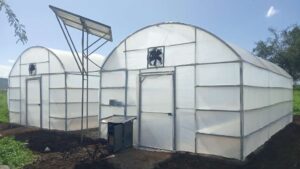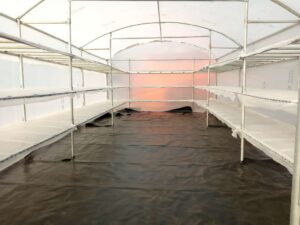Solar Dryers For Fruits And Vegetables

Grekkon Limited’s hybrid solar dryers for fruits and vegetables in Kenya are designed to dry faster than the conventional or natural solar dryers. They are enhanced with cyclone roof top vents, and fans on the sides. Hybrid solar dehydrators are efficient for large- scale commercial food drying. This is especially with longer to dry fleshy food like; cassava, banana, tomato, fruits, and rice. Drying time is a factor of the food crop type, and the prevailing ambient temperature during the drying period. The quality of the dry produce is consistent. The dryer works through the greenhouse effect.
Solar Dryers For Fruits And Vegetable In Kenya
Solar Dryer Materials
- UV treated paper on the sides and roof. UV block treatment on the polythene paper extends it’s usable lifetime to 4 years. This treatment prevents UV degradation of the food crop. The polythene paper has anti-drip properties to keep dew from forming on the inside of the paper. Dew drops on the drying food will cause molding.
2. Galvanised steel support structure. Galvanised with food grade aluminum, or zinc
3. Concrete floor for the permanent/ immovable models
4. Heat absorbing and releasing dam liner to line the floor
5. Roof top cyclones. Ensures the air is evenly distributed within so that there are no air pockets. This results in evenness of drying for the produce. We install cyclone roof top vents from a particular solar dryer size
6. Fanning system. This comprises of;
- solar panels; to provide electric DC power
- a control box; to regulate electric current
- an inverter; to convert DC energy form the solar panels to AC to power the fans
- fans; an extraction fan to allow push in air, and an exhaust fan to move out accumulated moisture
7. Nets. High density UV treated nets on the air entry and exit points
8. Drying trays designed with material specific to food drying
Every material used is specific to solar dryers for fruits and vegetables to provide; efficiency, safety, and food quality

Solar drying units by Grekkon Limited in Taita Taveta county enhanced with a solar panel and battery to power cyclones, extraction and exhaust fans. They increase air movement in the solar dryer, thereby hastening the drying process, and also making it even
How To Use Solar Dryers For Fruits And Vegetables
- Chop or slice the produce into smaller pieces. This increases the surface area for drying
- Place these pieces on the drying trays
- Keep the door closed always to avoid food contamination
- Every drying 3 hours, monitor the moisture content using a moisture meter
Solar Dryers For Fruits And Vegetables
FAQs
1. What are the 2 types of solar dryers?
1.1. Passive solar dryers. They only utilise the sun’s warmth
1.2. Active solar dryers. These ar hybrid solar dryers that utilise both passive drying and biomass generated heat
2. How do you make a solar dryer?
Grekkon limited’s low cost solar dryers in Kenya are made from the following materials
2.1. A zinc or aluminum galvanised steel structure. It is rust free and easy to clean with plain water
2.2. UV treated greenhouse polythene with anti-drip properties. The UV treatment prevents food degradation by the sun’s UV rays. It ensures that the color, taste, scent, and nutritional value remains after the moisture is removed. The anti-drip treatment prevents moisture droplets from condensing on the paper and forming drop that will fall on the food. Such drops cause molding
2.3. A heat absorbent floor. his one absorbs heat during the day, and releases it at night reducing tea variance between day and night temperatures. Dew formation and mold development is aggravated by a huge difference between day and night temperatures
2.4. A UV treated heavy gauge insect net to protect the produce from insect pests. This insect net covers the air vents
For a hybrid solar dryer we add all or part of the following
2.5. A biomass combustion chamber with a pipe that carries the heat to into the solar dryer. This one is used at night when there is no sunshine, or on cloudy, cold or rainy days. It ensures continuous drying irrespective of the prevailing weather
2.6. A solar panel with a battery to power cyclones, and extraction and exhaust fan. This system speeds up the drying process by increasing air ,movement withing the solar drying chamber. And also help in evenness of drying in the chamber
3. What is the size of a solar dryer?
Your solar dryer size will be determined by the weight and volume of product dried per session. The larger it is, the larger will be your solar dryer
4. How do I choose a solar dryer size?
Grekkon Limited guides on the solar dryer size a client will need based on the produce type and drying quantity per session
5. What is the mot popular use of a solar dryer?
To cleanly extract moisture (dehydrate) from farm produce, yet retain all other qualities
6. What type of solar dryer is best?
A hybrid solar dryer is the best because it allows for continuous drying; both day and night, and on cloudy or cold days

Related Posts
Low Cost Solar Dryers
Grekkon Limited is the largest supplier of low cost solar dryers for agricultural products in Kenya . These low cost solar dryers work on...
Hybrid Solar Dryers For Sale In Kenya
Hybrid solar dryers for sale in Kenya by Grekkon Limited are active dryers designed to dry quicker, all year round. They are augmented units...
